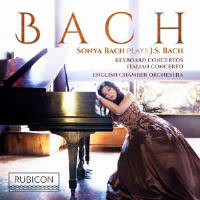Texte paru dans: / Appeared in: |
|
|
Outil de traduction ~ (Très approximatif) |
|
|
Reviewer:
Huntley Dent Bach is such a monumental figure that envisioning a human being behind the stoic portraits isn’t easy. But I was stuck that he took such personal delight in his Sonatas and Partitas for Solo Violin that he would often play them at the harpsichord, adding full harmony as he went along. Music’s great improvisers, including Beethoven, tease us by putting down so few of their spontaneous inventions, yet Bach made countless transcriptions and arrangements of his own and other composers’ works. One can imagine him playing the seven harpsichord concertos for the Collegium Musicum that met in Leipzig coffeehouses with the sense that the keyboard part does reflect his improvisatory style, not to mention how he enjoyed his own skills as a performer—these works are melodic and smiling on the whole, even when cast in a minor key. Outside a chamber setting, the modern alternative in the concert hall is to play the concertos on the piano, as the Korean virtuoso Sonya Bach does quite successfully on her debut CD. Since this was my introduction to her, I spent some time online, discovering a remarkable musician. After beginning the piano at three and appearing in public after the age of five, Ms. Bach attended Juilliard, where she won the Gina Bachauer Award as a teenager in 1996. She was among the last students of Lazar Berman in Italy and had a close tutelage with Alicia de Larrocha before the latter’s death. There are samples online of her playing the Rachmaninoff Third Piano Concerto at 16, as well as fiendish virtuoso challenges such as Balakirev’s Islamey. Pianists of such enviable accomplishment often declare their personal allegiance to the purity of Bach, but in this case there’s a special connection given that counterpoint came so naturally to Sonya Bach as a child that by the age of 10 she had the Well-Tempered Clavier in her repertoire, as she informs us in a booklet note. (Bach’s keyboard concertos don’t display the panoply of modern virtuosity, but you can hear Ms. Bach on YouTube let fly at Godowsky’s Golden Age transcription of the last movement of Sonata No. 2 in A Minor for Solo Violin—it’s brilliantly done.) Bach raised the harpsichord from its customary role of playing continuo to solo status in the Fifth Brandenburg Concerto, which famously features a 65-measure cadenza, thus creating a feature that piano concertos would adopt thereafter. But despite his prowess as a harpsichordist, Bach didn’t go on to write a body of original concerto works for the instrument. One might conjecture that he was inhibited by the recessive volume level of the harpsichord in an orchestral setting. Except for No. 6, which features two recorders, Bach restricted the accompaniment of his keyboard concertos to violins, violas, and continuo (No. 6 is omitted here). Besides the three works known to be transcriptions of the two Violin Concertos in E (which became Keyboard Concerto No. 3) and A Minor (Concerto No. 7), and a transposition of the Fourth Brandenburg Concerto as No. 6, musicology has concluded that none of the other works is entirely original either. Connections have been made to obbligato organ parts in a number of cantatas, and there’s discussion over whether Bach worked from violin and oboe d’amore concertos that are now lost. Ms. Bach delivers what she calls a “rigorous” reading of the piano part, implying that she conveys the even tone and dynamics of the harpsichord as opposed to the more Romantic style of employing the full expressive range of a modern concert grand. When Mendelssohn began the 19th-century performance tradition in these works, it came naturally for him to use the keyboard style he was familiar with. To eschew the piano’s Romantic side takes discipline, and the first thing one admires in Ms. Bach’s playing is her absolute evenness and control. Rhythms are precise, her touch is totally uniform, and the clarity of each voice is perfectly delineated. The effect is to make the constant stream of rapid passagework and contrapuntal interplay sound quite dazzling. There’s a poised assurance about her readings, rounded out by the excellent accompaniments by the English Chamber Orchestra. Their style of string playing reflects a pre-HIP approach from around the heyday of Neville Marriner, which is full and warm.
As I
listened I became more impressed by the way Ms. Bach astutely used
self-effacement to turn these works into the play of soloist and ensemble as
one. She ends the program with the Italian Concerto, done with buoyant
exuberance and élan. One could hardly ask for more. Good recorded sound is
faithful to the impressive range of her Steinway piano. | |
|
Support us financially by purchasing this disc from eiher one of these suppliers. Un achat via l'un ou l'autre des fournisseurs proposés contribue à défrayer les coûts d'exploitation de ce site. |
|
|
|
|
|
Cliquez l'un ou l'autre
bouton pour découvrir bien d'autres critiques de CD |
|




